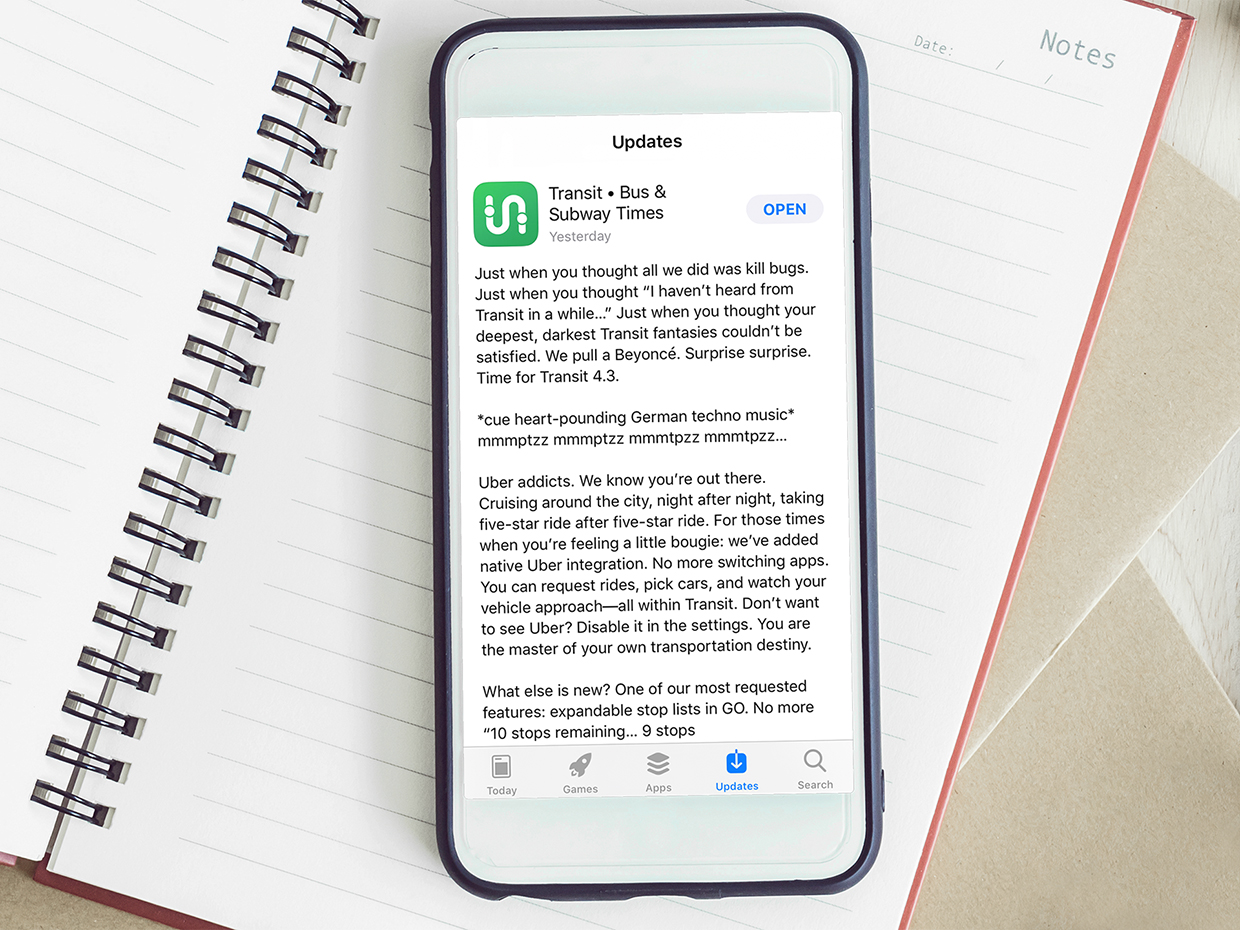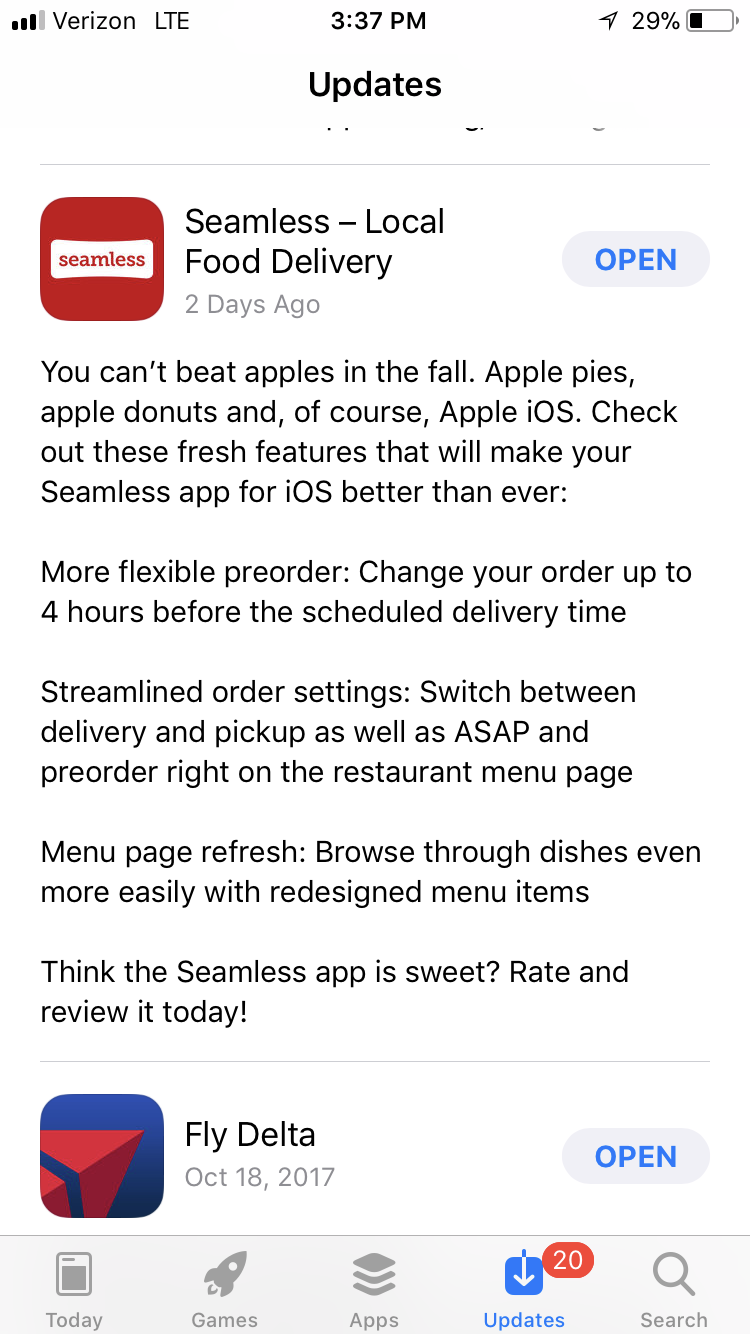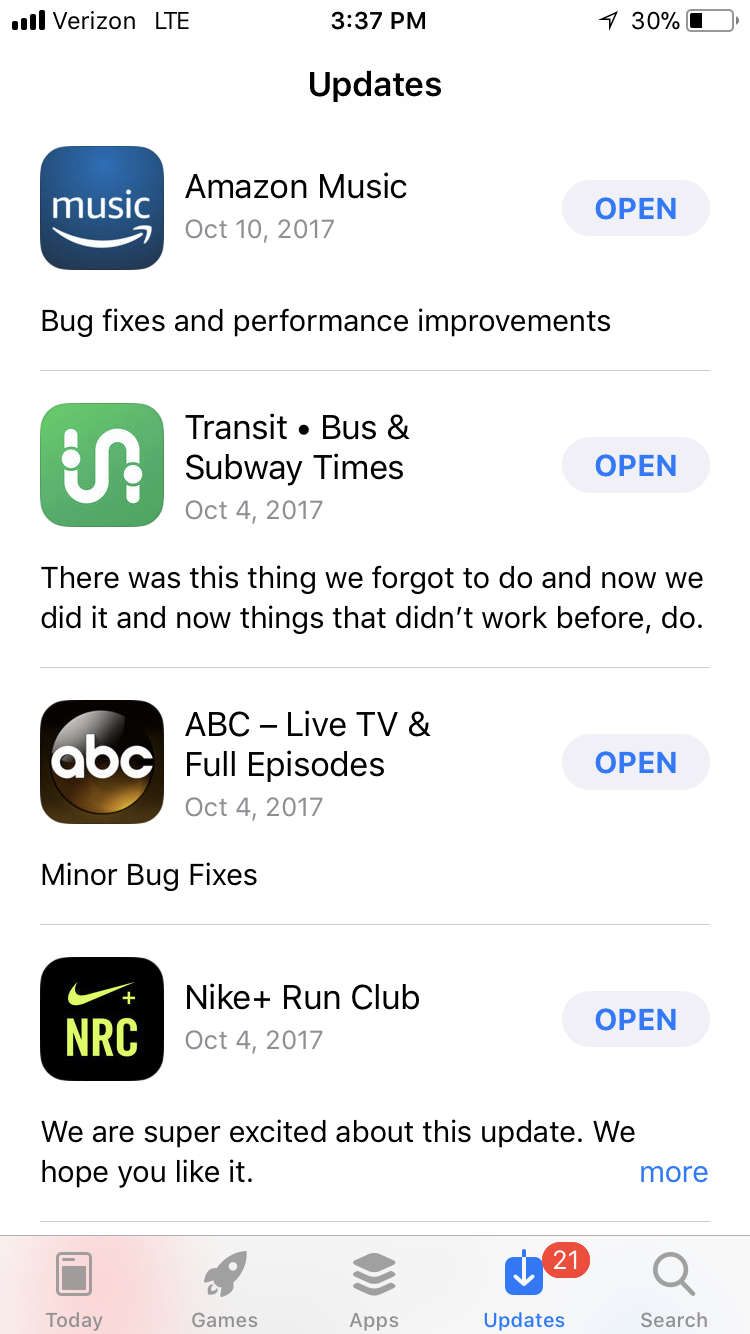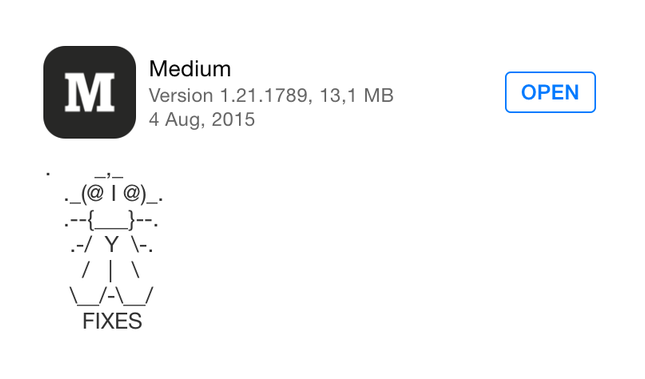The strange art of drafting explanations for the release of applications

If you have an iPhone, go to the App Store and open the updates. You will see explanatory notes describing the changes made by developers in the newest versions of your phone's applications. For the most part, they are pretty boring:
- Bug fixes and performance updates.
- Bug fixes.
- The update contains improvements in stability and speed.
- Update optimizes the processing of notifications.
But sometimes a note stands out. Recently looking at my own upgrades, I came across one of them, written for a transportation application called Transit, which I often use in New York.

Only you decided that we are only wetting bugs. Only you thought: “I haven’t received messages from Transit for a long time.” Only you thought that your deepest and darkest fantasies associated with Transit are unrealizable. How are we suddenly here. Surprise, surprise. It's time for Transit 4.3
* German techno turns on, from which the heart beats faster *
tuna-tuna-tuna-tuna-tuna-tuna-tuna…
Fans of Uber. We know that you are. You drive around the city, every night, on one five-star car after another. Especially for those cases when you decide to do something unusual, we added native Uber integration. No more switching applications. You can request a trip, choose a car, watch the car approach, and everything is inside Transit. Do not want to see Uber? Disable it in the settings. You are the master of your travels.
What else is news? One of the most requested features: expanding stop lists in GO. No more "10 stops left ... 9 stops ...".
I became interested in this description and found its author - Joe McKille, Transit's full-time copywriter. “I think I was hired mainly to write release notes,” he told me. And this is in his work he likes most.
Solasno MacNeil, Transit believes that release notes are one of the best ways to communicate with users. “In the company, explanations are treated as seriously as blog entries,” he says. Different draft versions are transmitted between people. “The team treats them very demanding,” he says. “If I get a bad joke, they don’t miss it.”
Release Notes - Developer’s method to inform users about what has changed in the application running on their phone. They describe new features and keep users informed about important software changes. Updating applications is a good digital hygiene practice, as newer versions fix problems and eliminate vulnerabilities.

In autumn, nothing compares to apples. Apple Pies [ Apple Pie is one of the typical dishes of the US cuisine / approx. trans. ] apple donuts, and of course, Apple iOS. Check out these fresh features that will make your Seamless app better than ever:
More flexible pre-order system: you can change an order up to 4 hours before delivery.
Convenient order settings: switch between delivery and pickup, as well as between delivery if possible and pre-order directly on the restaurant menu page.
Updating the menu: it became even easier to choose dishes thanks to the redesigned menu items.
Think Seamless is cool? Rate and write reviews right now!
But writing explanations for the release is hard. Often, they are made by someone already when the development team is ready to place a new code in the app store — simply as an afterword. “With us, this was once the last item on the list, and no one paid any attention to it,” said Rob Gill , the former user perception manager at the Perform Group, who managed the development of dozens of applications.
As a result, the explanations for the release of many applications are boring. They repeat several common phrases, often these are variants of the phrase “fixing bugs” and “updating performance”.
But some explanations, and their authors, demonstrate individuality. MacNil of Transit is one of them. Greg Geldner , working on services for users in Medium, is another one. A few years ago, Geldner noticed how boring the release notes were. “These are just bug fixes, all about fixing bugs,” he says.

He and colleague Nick Fisher volunteered to start writing them for Medium, seeing "a small opportunity to make fun of each other." Their job was to share ideas with each other until one of them laughed. In her notes, Medium placed a contest for T-shirts , published a chat for developers on Slack , wrote a fictional story about programmer Peter , who was hired, and then fired for working on the application.
“At first, we didn’t think much about conveying any real information,” Geldner admits. For one important update that allowed users to log in via email and a Facebook account, he and Fisher wrote explanations, using the word-play based on Kenny Loggins' songs many times. It was a fiasco - no one knew what improvements were actually made.
Gill of the Perform Group recently wrote a blog entry urging developers to write release notes. He advises authors to use lists with markers, separate paragraphs and indicate a simple and clear summary of the main changes at the very beginning. Some of his favorite notes come from Evernote , 1Password and Tumblr .

They are ugly, creeping and disgusting. Yes, we are now about bugs. What is the good news? We eliminated a bunch of them from this release of the Yelp application.
When a note does not reach a goal, like Loggins, Geldner says that he will find out about it from Medium users. “Usually you get instant feedback through Twitter and the app store,” he says. - People write like "Enough of these stupid notes, tell me what is there".
Now Geldner is trying to screw up a little humor and give more useful information when Medium plans a major update. Once he even published a slightly modified code from the update itself in the release notes. McNeil uses a similar approach in Transit, holding his creativity a little while the application is undergoing major changes.
But it is impossible to please everyone. The 2015 article from TechCrunch, entitled “ Explanations for application releases are getting stupid, ” denies both trivial updates and attempts at “performance”, such as when Medium added an ASCII bug with the word “FIXES” (corrected) to the note.

Some critics of this unusual genre like to say that nobody reads these explanations anyway, especially when users can allow automatic application updates . But one of the explanations McNeil got on the first page of reddit . On Twitter, Transit users are asked to post his photos , recommend raising his salary and begging him not to stop writing explanations.
In Medium, Geldner often turns to popular culture in search of inspiration — it can come from a Christmas song, political debate, film. His work sometimes slips because he has been writing explanations for almost three years. “I have already forgotten a lot of them,” he says. - This too often happens. I propose: “Let's make a Jurassic Park,” and someone replies: “So we did it already.”

Why write explanations of releases, if you can play in the "gallows"? yo
For Geldner and Macknil these are tasks of both professional and personal nature. "I would say that the authors who write explanations for the releases do not know each other," says McNeil. “But there is definitely a contest between us.”
Explanation McNeil caused a quarrel on Twitter between Transit, Pocket Casts and Medium . He was also a guest star in the release notes for other applications, including Medium .
For those who want to make a name for themselves on writing notes to releases, he has advice. “I would say, be open to new ideas, and maybe sip a beer before writing,” he says. “There are no rules here.”
All Articles